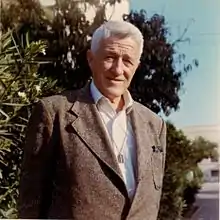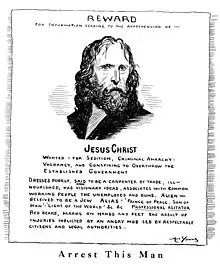Ammon Hennacy
Ammon Ashford Hennacy (July 24, 1893 – January 14, 1970) was an American Christian pacifist, anarchist, social activist, member of the Catholic Worker Movement, and Wobbly. He established the Joe Hill House of Hospitality in Salt Lake City, Utah and practiced tax resistance.[1]
Ammon Hennacy | |
|---|---|
 Hennacy in 1966 | |
| Born | July 24, 1893 Negley, Ohio, US |
| Died | January 14, 1970 (aged 76) |
| Spouse(s) |
|
| Part of the Politics series on |
| Anarchism |
|---|
 |
|
| Part of a series on |
| Socialism in the United States |
|---|
|
| Part of a series on |
| Libertarian socialism |
|---|
 |
|
Biography
Hennacy was born in Negley, Ohio, to Quaker parents, Benjamin Frankin Hennacy and Eliza Eunice Fitz Randolph, and grew up as a Baptist. He studied at three different institutions, (a year at each one): Hiram College in Ohio in 1913, University of Wisconsin–Madison in 1914, and The Ohio State University in 1915.
During this time Hennacy was a card-carrying member of the Socialist Party of America and in his words "took military drills in order to learn how to kill capitalists."[2] He was also the secretary of Hiram College's Intercollegiate Socialist Society.[3]
At the outbreak of World War I Hennacy was imprisoned for two years in Atlanta, Georgia for resisting conscription. While in prison the only book he was allowed was the Bible. This inspired him to radically depart from his earlier beliefs; he became a Christian pacifist and a Christian anarchist. He led a hunger strike and was punished with eight months in solitary confinement.[4]
Hennacy believed that adherence to Christianity required being a pacifist and, because governments constantly threaten or use force to resolve conflicts, this meant being an anarchist.

In 1919 Hennacy married his first wife, Selma Melms, under common law.[6] He later described her as the "daughter of the Socialist sheriff of Milwaukee, leader of the Yipsels, as the young Socialists were called, and secretary to the President of the State Federation of Labor."[5]
In May 1920, Hennacy graduated from the socialist Rand School of Social Science.[7] In 1921, Hennacy and Melms hiked around the United States passing through all 48 of the contiguous states. He settled down in 1925, buying a farm and raising his two children. In 1931, he began social work in Milwaukee and organised one of the first social worker unions.
He refused to use force or self-defense even when threatened during his work, preferring instead to use nonresistance. During this time, he also refused to sign up for the draft for World War II and declared that he would not pay taxes. He also reduced his tax liability by taking up a lifestyle of simple living. Between 1942 and 1953, Hennacy worked as a migrant farm labourer in the southwest United States.
In 1952, he was baptized as a Roman Catholic by Father Marion Casey at St. Anastasia Church with Dorothy Day as his godmother. Hennacy moved to New York City in 1953, and became the associate editor of the Catholic Worker. Hennacy engaged in many picketing protests while in New York.
At that time, he wrote a critical review of Witness, memoir of Whittaker Chambers, and later wrote more about his dislike of Chambers, whose wife Esther Shemitz his first wife Selma and he had known through the Rand School of Social Science.[5] He illegally refused to participate in New York City's annual air raid drills, and he picketed against the Atomic Energy Commission's war preparations in Las Vegas, Cape Kennedy, Washington, D.C., and Omaha. In 1958, Hennacy fasted for 40 days in protest of nuclear weapons testing.
In 1961, Hennacy moved to Utah and organised the Joe Hill House of Hospitality in Salt Lake City. While in Utah, Hennacy fasted and picketed in protest of the death penalty and the use of taxes in war. Following a divorce from Selma in 1964, Hennacy married his second wife, Joan Thomas, in 1965. In the same year he left the Roman Catholic Church, though he continued to call himself a "non-church Christian".[8]
He wrote about his reasons for leaving and his thoughts on Catholicism, which included his belief that "Paul spoiled the message of Christ" (see Jesusism). This essay and others were published as The Book of Ammon in 1965, which has been praised for its "diamonds of insight and wisdom" but criticised for its rambling style.[9]
In 1968, Hennacy closed the "Joe Hill House of Hospitality" and turned his attention to further protest and writing. His second and last book, The One-Man Revolution in America, was published in 1970 and consists of seventeen chapters with each one devoted to an American radical. These included Thomas Paine, William Lloyd Garrison, John Woolman, Dorothy Day, Eugene Debs, Malcolm X, Mother Jones, Clarence Darrow and Albert Parsons.[10]
Ammon Hennacy died from a heart attack on January 14, 1970. In accordance with his wishes, his body was cremated and the ashes scattered over the graves of the Haymarket anarchists in Waldheim Cemetery in Chicago.[11]
Political and ethical beliefs
Ammon Hennacy was a pacifist, a Christian anarchist, and an advocate of anarchism and nonresistance. He was extremely critical of what he described as the "institutional church"[12] and state capitalism.[13]
He did not drink or smoke and was a vegetarian. Much of his activism was anti-war, anti-nuclear proliferation, and against the death penalty.
Hennacy never paid federal income taxes because they pay for the military and war. He lived a life of voluntary simplicity and believed in what he called his "One-Man Revolution" against violence, sin, and coercion.[14] He also refused to accept the legitimacy of the judiciary. Dorothy Day said "Tolstoi and Gandhi, and Jesus became his teachers".[15][16]
Influence on folk
When Ani DiFranco gathered stories by Utah Phillips to make the 1996 album The Past Didn't Go Anywhere, she included his story about Hennacy, under the title "Anarchy". Hennacy helped shape Phillips, who often told this story.[17]
Film
- Page, Marcus P. Blaise (2005) A Peace of the Anarchy: Ammon Hennacy and Other Angelic Troublemakers in the USA on YouTube
Bibliography
- The Autobiography of a Catholic Anarchist (1954) Catholic Worker Books, New York. Reprinted by Literary Licensing, Whitefish, 2011. ISBN 978-1258202330. Complete e-text, free eBook.
- The Book of Ammon (1965) Ammon Hennacy Publications, Salt Lake City (lengthened version of The Autobiography of a Catholic Anarchist, includes the years 1955 to 1964). Reprinted by Wipf and Stock, Eugene, 2010. ISBN 978-1-60899-053-5. Complete e-text, free eBook.
- The One-Man Revolution in America (1970) Ammon Hennacy Publications, Salt Lake City. Reprinted by Wipf and Stock, Eugene, 2012. ISBN 978-1-62032-317-5.
References
- Day, Dorothy (February 1970). "Ammon Hennacy: 'Non-Church' Christian". The Catholic Worker. Archived from the original on 2013-04-06.
- Ammon Hennacy, an anecdotal sketch by Don Dedera
- "In the Colleges – The Middle West".The Intercollegiate Socialist, Vol. 2, No. 2. (December-January, 1913-1914), 24.
- Gross, David M. (2014). 99 Tactics of Successful Tax Resistance Campaigns. Picket Line Press. pp. 224–25. ISBN 978-1490572741.
- Hennacy, Ammon (1965). The Book of Ammon. Hennacy. pp. 7 (Selma), 235 (Esther Shemitz), 236 (Whittaker Chambers), 245-247 (Whittaker Chambers), 254 (Whittaker Chambers), 267 (Whittaker Chambers), 332 (reward poster).
- Coy, Patrick G. (1988). A Revolution of the Heart: Essays on the Catholic Worker. Temple University Press. p. 149. ISBN 978-0-87722-531-7.
- "Tenth Full-Time Class of Rand School Will be Graduated Tomorrow Night" (PDF). The New York Call. 7 May 1920. p. 8. Retrieved 4 February 2018.
- Thomas, Joan. "Ammon Hennacy: A Brief Biography". Archived from the original on 2008-02-25. Retrieved 2008-02-25.
- Coy, Patrick G. (1988). A Revolution of the heart: essays on the Catholic worker. Temple University Press. p. 142. ISBN 9780877225317.
The book does contain diamonds of insight and wisdom, and is important in its own right for the rich detail it offers not only into Hennacy's life but into the history of the movements he was a part of. Unfortunately, many of these diamonds are buried under the weight of more than five hundred pages of discursive ramblings.
- Coy, Patrick G. (1988). A Revolution of the heart: essays on the Catholic worker. Temple University Press. p. 140.
The One-Person Revolution of Ammon Hennacy
- Coy, Patrick G. (1988). A Revolution of the heart: essays on the Catholic worker. Temple University Press. p. 168.
The One-Person Revolution of Ammon Hennacy
- "Ammon Hennacy: 'Non-Church' Christian by Dorothy Day". Archived from the original on 2004-08-04. Retrieved 2004-09-05.
- "Ammon Hennacy, On the refusal to pay taxes (1954-1965)". Panarchy.org. Retrieved November 25, 2020.
- Gross, David M. (2014). 99 Tactics of Successful Tax Resistance Campaigns. Picket Line Press. pp. 223–38. ISBN 978-1490572741.
- The Long Loneliness by Dorothy Day, HarperCollins, p. 265.
- "The Conversion of Ammon Hennacy". The Catholic Worker, 2 January 1953. Archived from the original on 2009-02-18. Retrieved 27 May 2010.
- Rattler, Fast. "Utah Phillips on the Catholic Worker, Polarization, and Songwriting". Archived from the original (interview) on 2007-12-12. Retrieved 2008-03-01.
Further reading
- Thomas, Joan (1993) The Years of Grief and Laughter: A "Biography" of Ammon Hennacy. Baltimore, MD, Fortkamp Publishing Co. Reprinted by Wipf and Stock, Eugene, 2012. ISBN 978-1-62032-352-6.
External links
- Ammon Hennacy – A One-Person Revolution in America
- The Ammon Hennacy Papers
- Ammon Hennacy: an anecdotal sketch by Don Dedera
- Ammon Hennacy Page (with chronology, bibliography, links) - Anarchist Encyclopedia
- The authorized biographical movie – by Lovarchy-Shalom Productions
- A review of Hennacy's autobiography: The Book of Ammon
- The Autobiography of a Catholic Anarchist by Ammon Hennacy
- "Remembering Ammon Hennacy" by James F. Holwell
